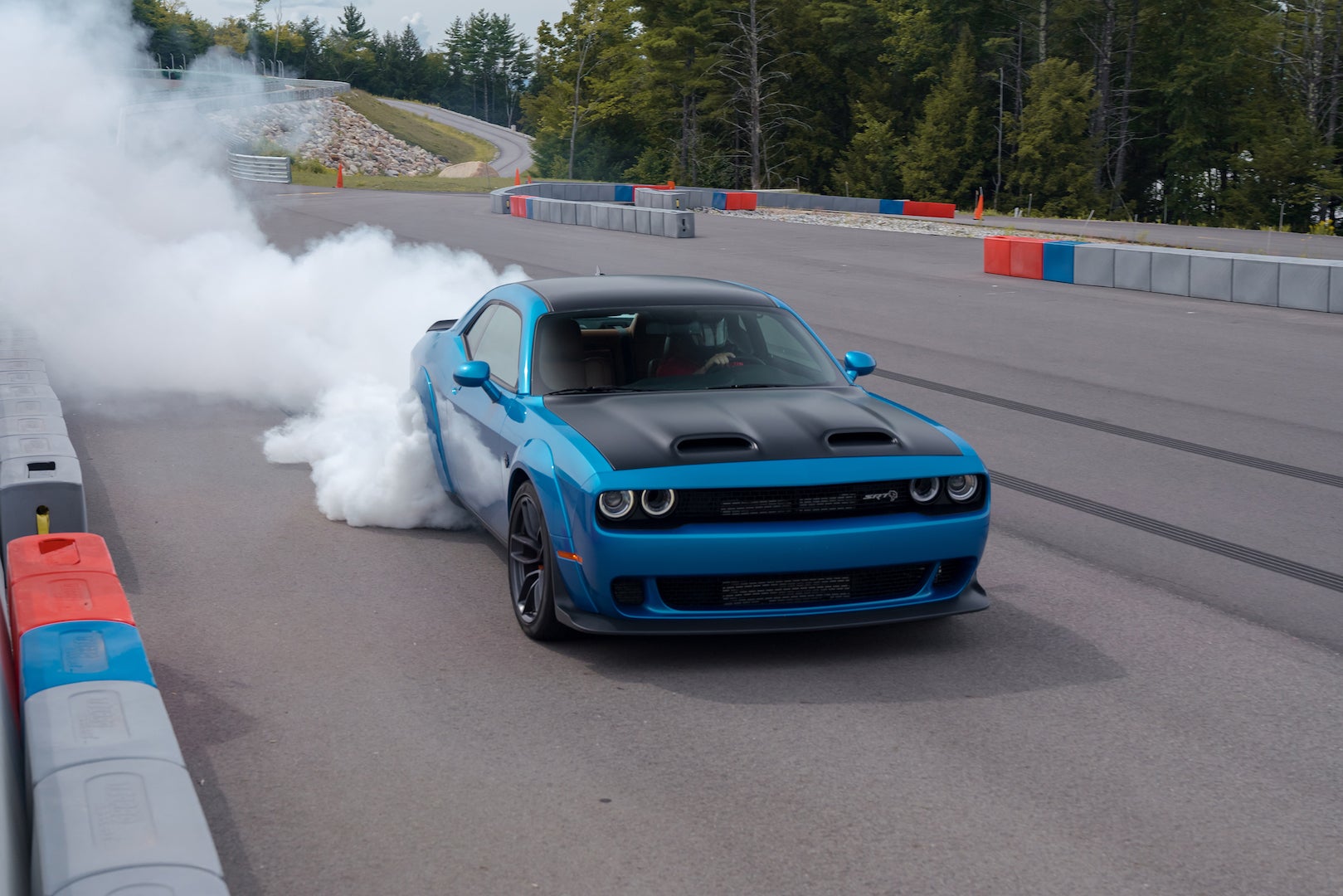How many Challengers does the world need? According to Dodge, so, so many—enough Mopar muscle cars to light up every drag strip and stoplight in America, and maybe spark a few police pursuits for our YouTube delectation. For whatever reason—perhaps a new challenge for the Challenger—Dodge chose an unusual place for us to drive its newest muscle babies: A place where the road turns both left and right, hills run up and down, and the nearest stoplight is one town over. Namely, Club Motorsports, a relatively-new gem of a road course in Tamworth, New Hampshire, with 2.5 miles, 15 turns and about 250 feet of roller-coaster elevation changes. A hardcore drag racer would get vertigo around here, or ask what those green things were surrounding every inch of track. Them’s called “trees,” Bubba.
In other words, while this forested, hillside track is going to look gorgeous come fall, this is hardly the Challenger’s home turf. Still, Dodge invited us to drive what’s surely the best-handling version yet, despite a 485-hp V8, that, by Dodge’s fire hose power standards, is a kale-clogged peashooter: the 2019 R/T Scat Pack Widebody. Particulars include a stiffened adaptive suspension, six-piston Brembo brakes and 3.5-inch fender flares, and wider, stickier Pirelli tires (sized 305/35ZR20) on 20x11 inch forged aluminum wheels. Spring rates are 14 percent firmer up front, with retooled shock valving and larger anti-sway bars.
Whether wide-bodied or standard-width, every 2019 R/T Scat Pack gets standard goodies from the Challenger Hellcat, including automated launch control, launch assist and SRT drive modes. Also, the Line Lock feature that disables rear brakes to allow drivers to roast tires like so many Stay-Puft Marshmallow Men.
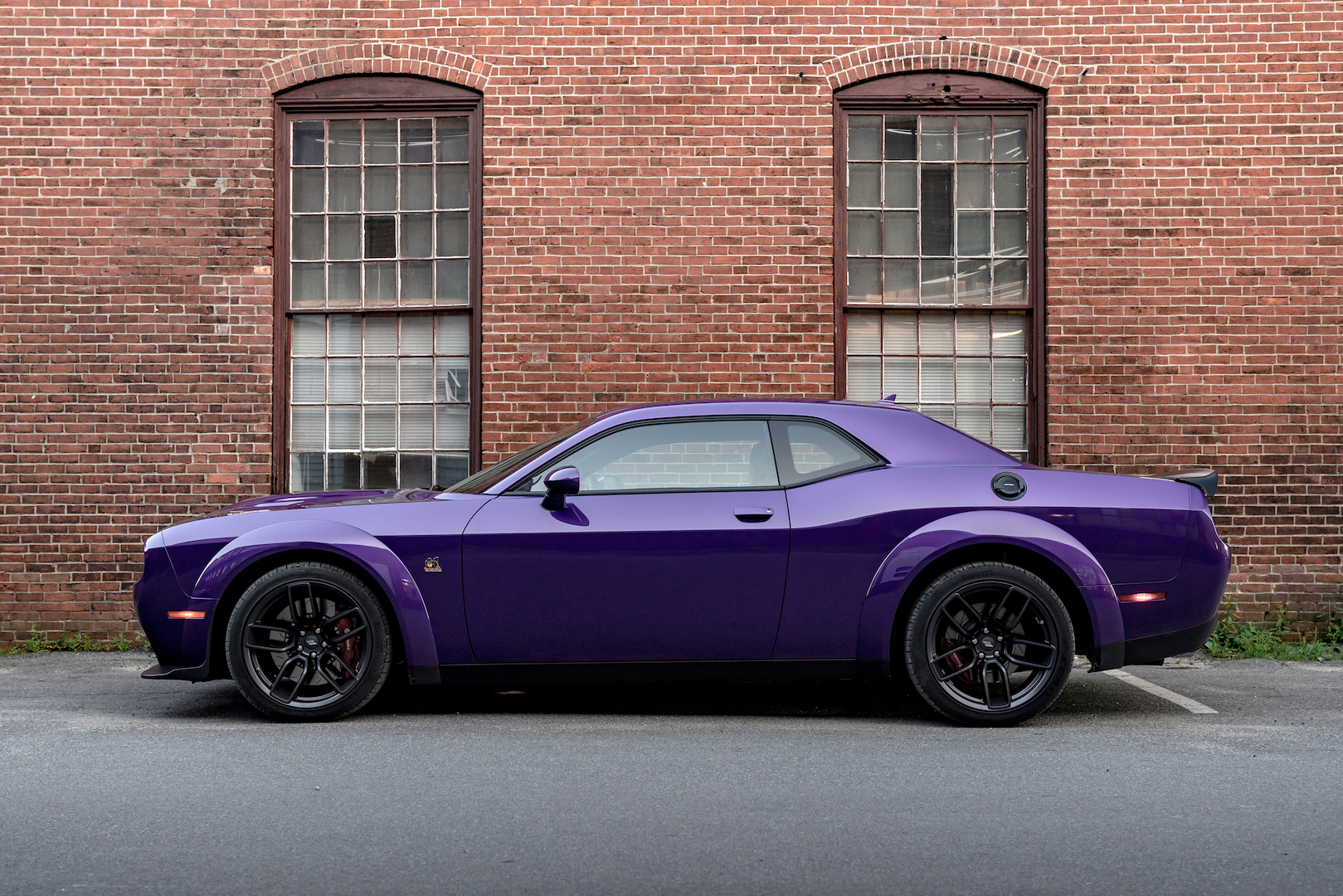
The hottest, rarest roaster of them all, the notorious 840-hp Demon, has been sent to the netherworld after a one-year, 3,300-unit model run out of Brampton, Ontario. Taking the Demon’s place—as though anything could take its place—is the Challenger SRT Hellcat Redeye. Its odd name refers not to an overnight flight with Lucifer's felines, but to the red, “jewel-like” eye affixed to the fender’s Hellcat badges. You know Dodge, and how much fun they have with names and logos.
Before you shed red tears for the Demon, be aware that Dodge still touts the Redeye as the most powerful, quickest, and fastest muscle car in the land. It definitely snapped my neck every time I goosed its Hemi V8. 797 horsepower and 707 pound-feet of torque have a way of doing that. That 6.2-liter Hemi is essentially a Demon engine— right down to the fridge-sized, 2.7-liter supercharger—minus the calibration that let it chug 100-plus-octane racing fuel. So we’re still talking a muscle car that knock off 60 mph in 3.4 seconds, and the quarter-mile in 10.8 seconds at 131 mph (in fat-tired, fender-flaring Widebody guise). That’s also 0.1 seconds quicker, and four mph faster at the trap, than a standard Hellcat—which itself has been boosted by 10 hp for 2019, to 717 horses.
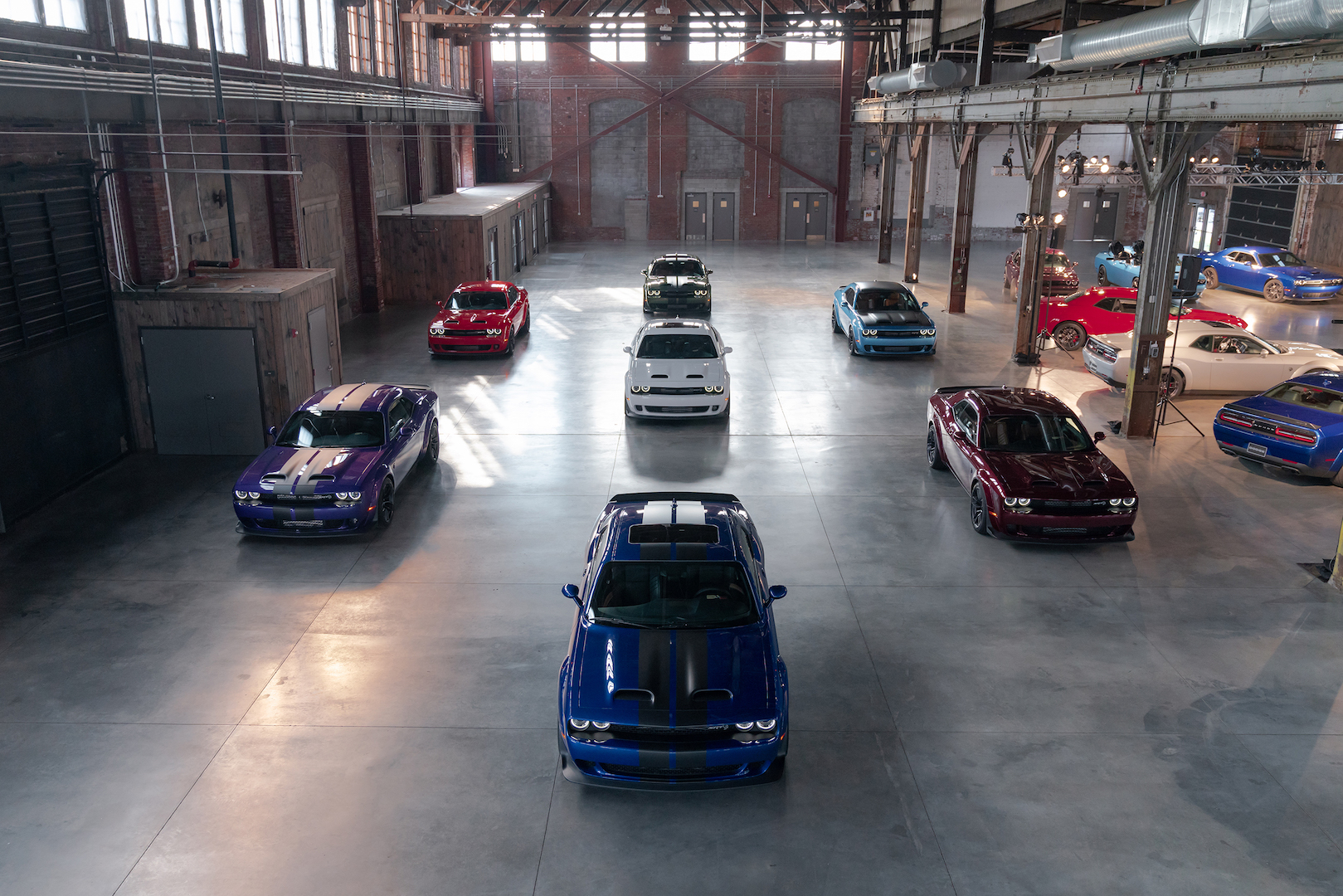
Yes, the Demon recorded a record-setting 9.65 seconds in the quarter mile. That roughly 1.1-second edge in quarter-mile acceleration is largely due to its near-slick, street-legal drag radial tires, myriad chassis adjustments to encourage rearward weight transfer for even more explosive starts, and that ability to chug special racing fuel. But the Redeye finds its own bragging rights in a speedier spectrum: Where the strip-focused Demon was electronically limited to 168 mph due to its Nitto drag radial tires, the Redeye romps to a breathtaking 203 mph.
The price is breathtaking, too. At the low end, you can still buy a 2019 Challenger for as little as $28,640, for a rear-drive SXT model with its 305-horsepower Pentastar V6. At the top, the Redeye, after a $1,700 gas-guzzler tax, will set you back $72,685 to start—an $11,000 upcharge from a standard 2019 Hellcat. Throw in the $6,000 Widebody package and sprinkle in some deluxe options, and the Redeye I drove cost $88,410. (Perhaps “Redeye” refers to what happens when you calculate the monthly payment).
Like every 2019 Hellcat, the Redeye adopts a sinister, dual-snorkel hood whose functional nostrils help maximize the intake of air. (That design theme nods to vintage Mopar muscle cars like the 1970 Dodge Dart Swinger and ’71 Demon.)
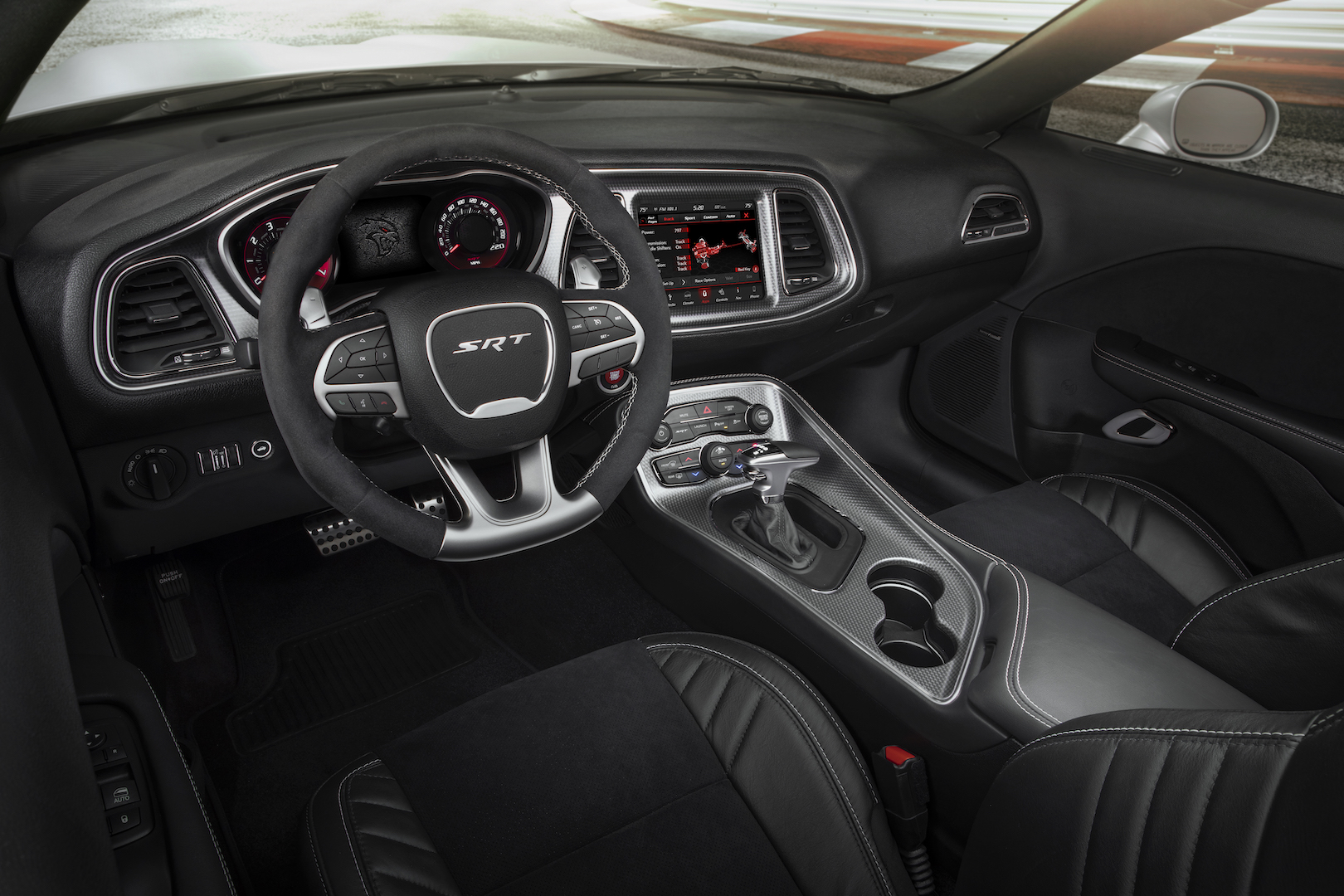
Oh, there’s more. The 485-hp R/T Scat Pack 1320—the “1320” refers to the number of feet in a quarter-mile—is designed as grassroots drag-racer for people (meaning most people) who are unwilling or unable to spring for a Hellcat. That includes Nexen 20-inch street-legal drag radials, an SRT-tuned adaptive suspension with a drag mode, and plenty of burnout-friendly Hellcat/Demon gear, including Line lock, TransBrake, torque reserve, and extreme-duty, 41-spline half-shafts. That Scat Pack 1320 starts from $44,125, a reasonable $3,995 upcharge over a standard R/T Scat Pack. A 1320 on display in a revamped Maine warehouse sported a kickass shade of dark, retro purple called “Black Eye.” The concept color was the top vote-getter among 15 paint shades shown to Fiat-Chrysler employees and enthusiasts. Dodge says it will gauge public feedback and decide whether to bring the Black Eye paint to showrooms. (We’ll guess the answer will be “yes.”)
The Challenger is one of those cars that looks great in so many colors that it’s hard to choose a favorite, as I appreciated while surrounded by a Crayola box' worth of choices. I'm partial to the retro green called F8 Green, or the equally-villainous Destroyer Gray, but also candy-colored shades like TorRed and Indigo Blue. And the available black hoods or racing stripes never look wrong on a Mopar.

Dodge says the Scat Pack Widebody will pull an impressive 0.97 g of lateral grip, versus 0.93 for the standard model. The Widebody version also runs two-seconds-per-lap faster at GingerMan Raceway in western Michigan. That’s an eternity in racing, about 12 car lengths for every go-round. The 485-hp Widebody is also faster in a straight line, shaving 0.1 seconds from the 0-60 mph clock (at 4.6 seconds with an automatic trans) and 0.2 seconds in a quarter-mile, with an elapsed time of 12.1 seconds at 112 mph.
By the time I'd learned all this at the drive event, my cranium was stuffed, forced-induction style, with so many stats, specs, and prices that I couldn’t possibly keep them all straight. But one number didn’t burn off with that evening’s beers, and I confirmed it with Dodge engineers: The R/T Scat Pack Widebody, they said, can circle that (admittedly cozy) GingerMan course as quickly as the narrower-tired, softer-sprung Hellcat, despite giving up 232 horsepower to the ‘Cat.
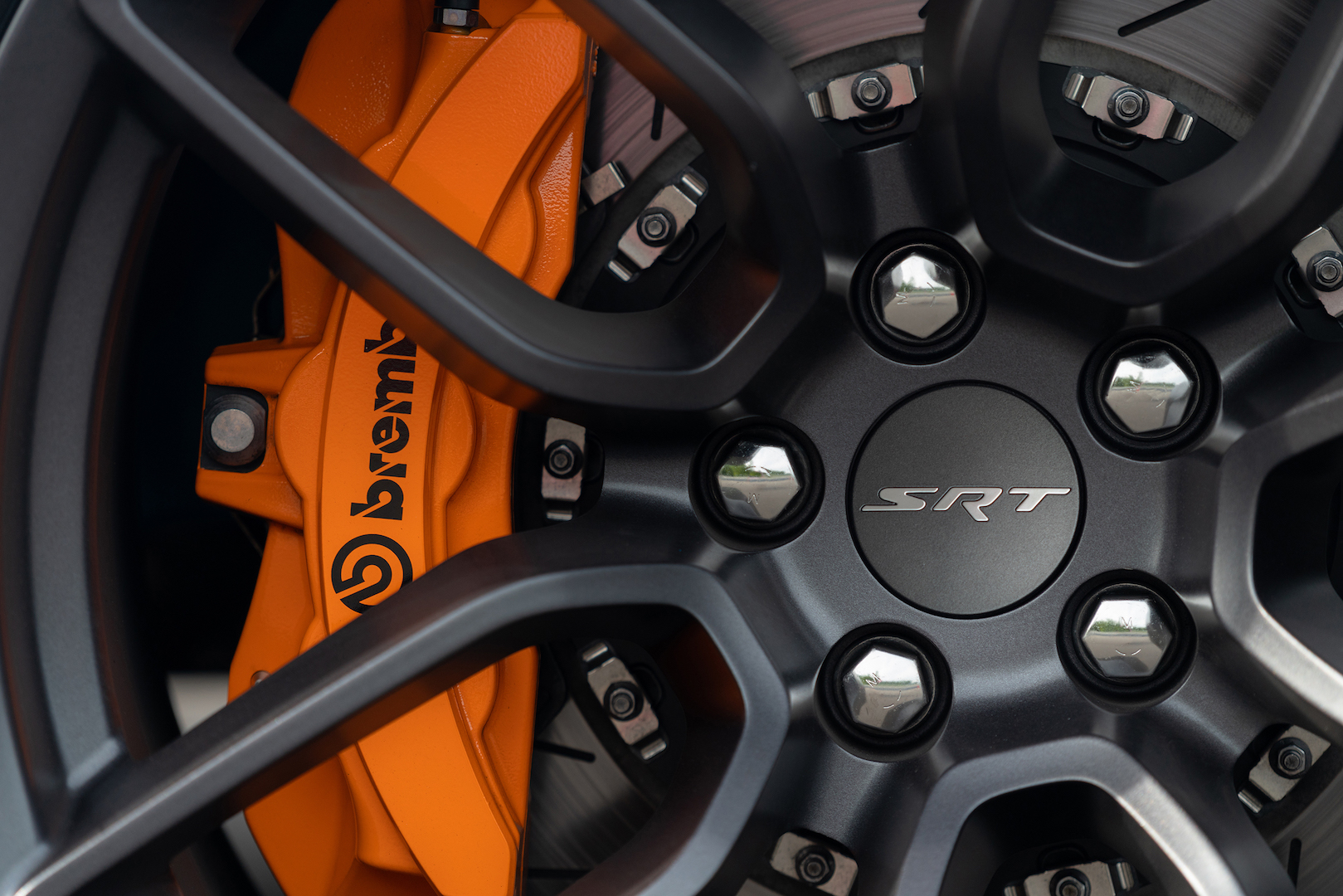
We put those performance claims to the test at Club Motorsports. With its wider rubber, stiffer suspension and superior power-to-chassis balance, the Scat Pack Widebody does feel significantly more stable and buttoned-down than the Redeye, and thus more fun to drive. And the Redeye? Like the Hellcat, it’s a bit like piloting a jet-powered BarcaLounger: Surprisingly comfortable and insanely fast, but also bulky, spongy, and isolated. Like the Hellcat on track, the best compliment I can offer is that the Redeye doesn't feel like it’s trying to kill you. The operative technique is to get your braking done extra-early, coast through the turn with a touch of maintenance throttle—wait for it, wait for it—and then roll every-so-gently back onto the gas to avoid spinning the tires or upsetting the chassis.
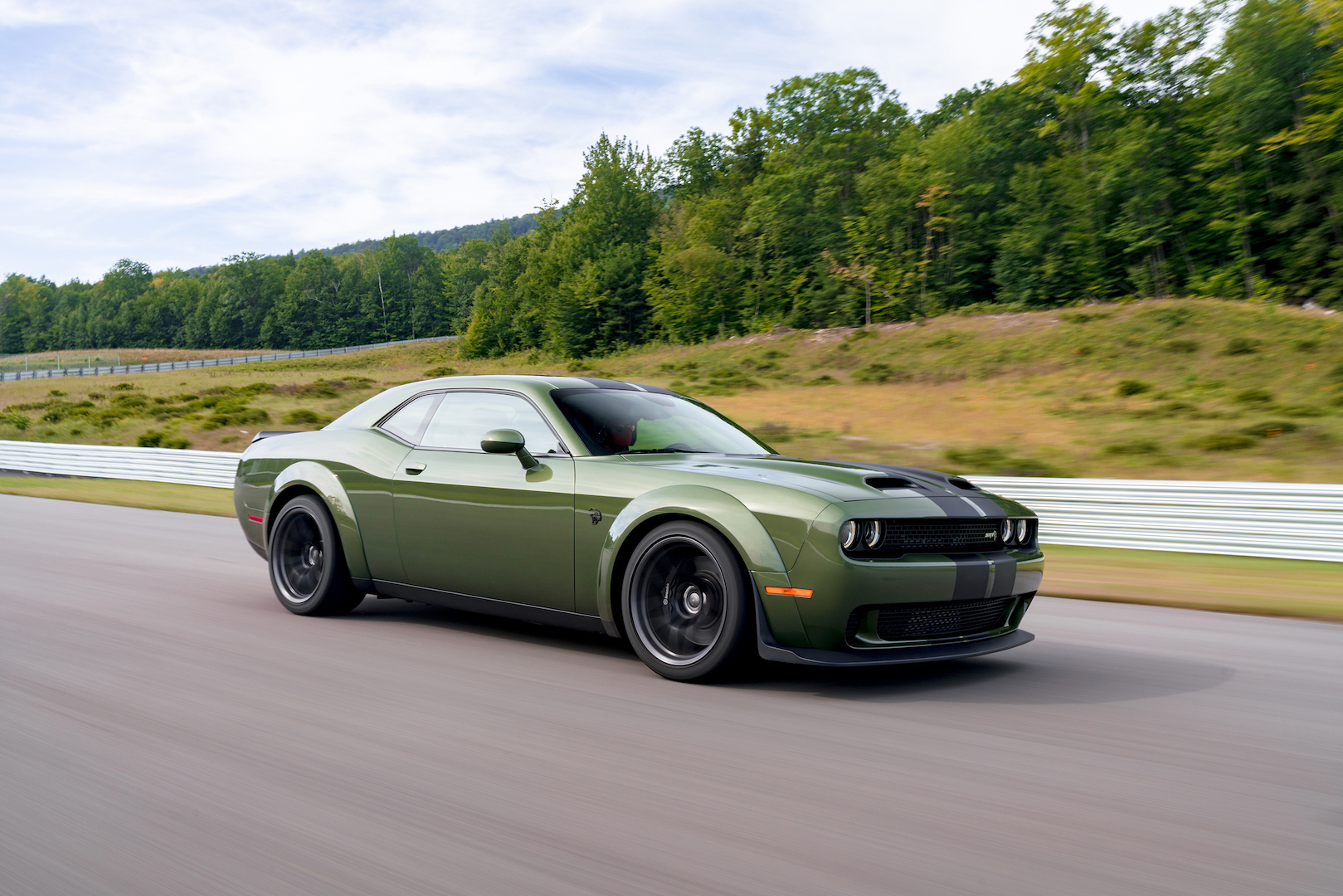
On track, whichever version we drive, the steering is a mite slow and stingy with feedback; the wheel itself is nicely grippy but too macho-thick. The eight-speed transmission also takes its sweet time, even when you use the plastic paddle shifters. Six-piston Brembo brakes feel surprisingly strong—Dodge claims a 108-foot stop from 60 mph, only a few feet more than a Ford Mustang GT Performance Pack. But the Challengers squirm under heavy braking, and you’re constantly aware that you’re tussling with a big, heavy machine.
Dodge engineers themselves hasten to note that even this R/T Scat Pack isn’t designed to be a track rat. If it were, at a curb weight approaching 4,300 pounds, it’d be the rat that even Remy from Ratatouille couldn’t keep fed. Instead, the idea was to create a Challenger that’s still plenty fast—including a 169-mph top speed, or 179 mph for the standard-width Scat Pack—but one that you can drive harder and more confidently. Consider that mission a success.
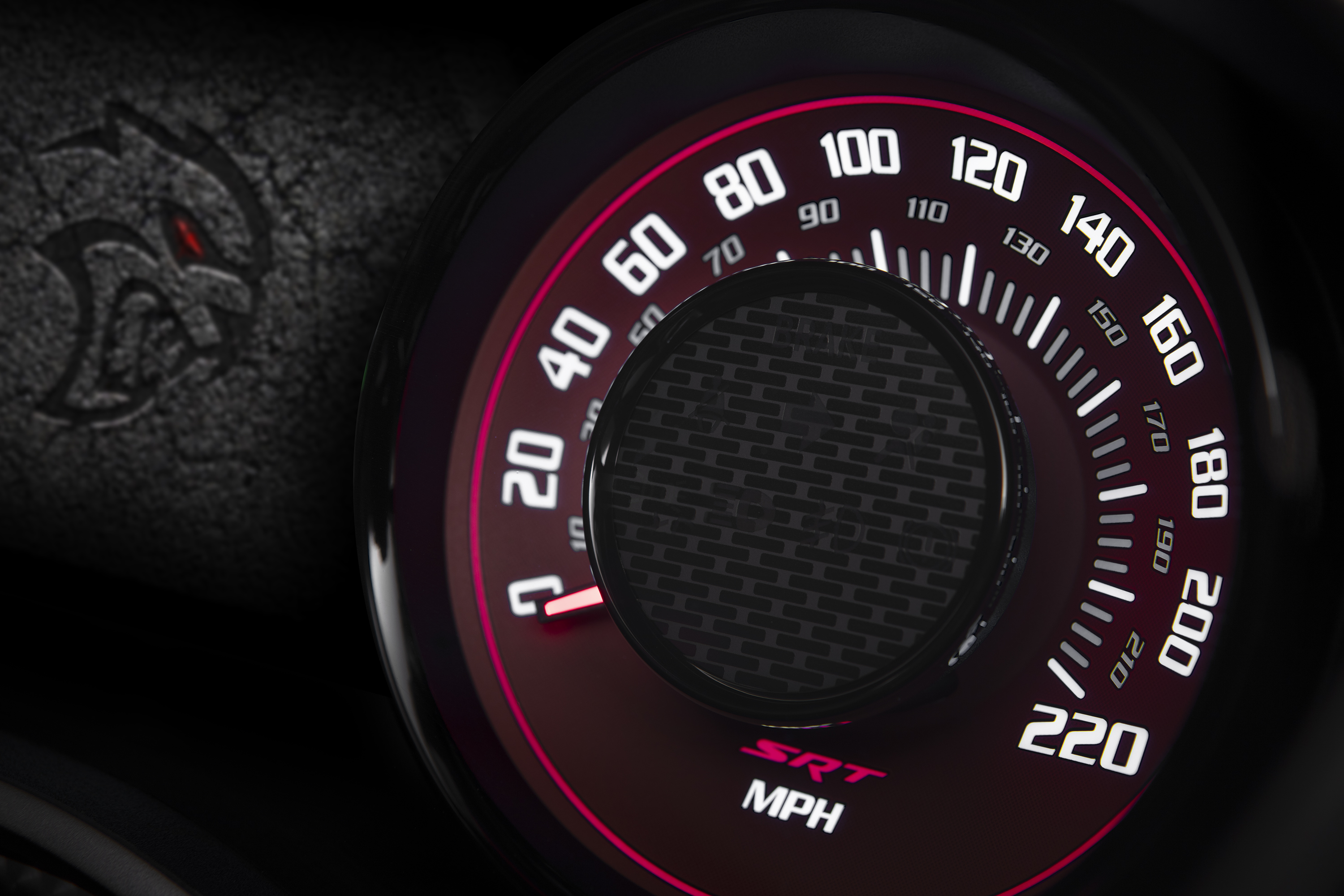
Far be it from me to spurn any form of track time; I’m the guy you have to drag out of the car at the end of the day, when other journalists have long since retired to a shady paddock and their cocktail shrimp. And yet, in the parking lot sat the Subaru WRX STI Type RA I’d driven up from Brooklyn, a holy terror of a track car. And as I felt out the track’s curling, 10-degree downhill grade in these Challengers—among the steepest plummets you’ll see on a course beyond Laguna Seca’s Corkscrew—I found myself wishing that I was attacking it in the Subaru, instead of tiptoeing in the Dodges.
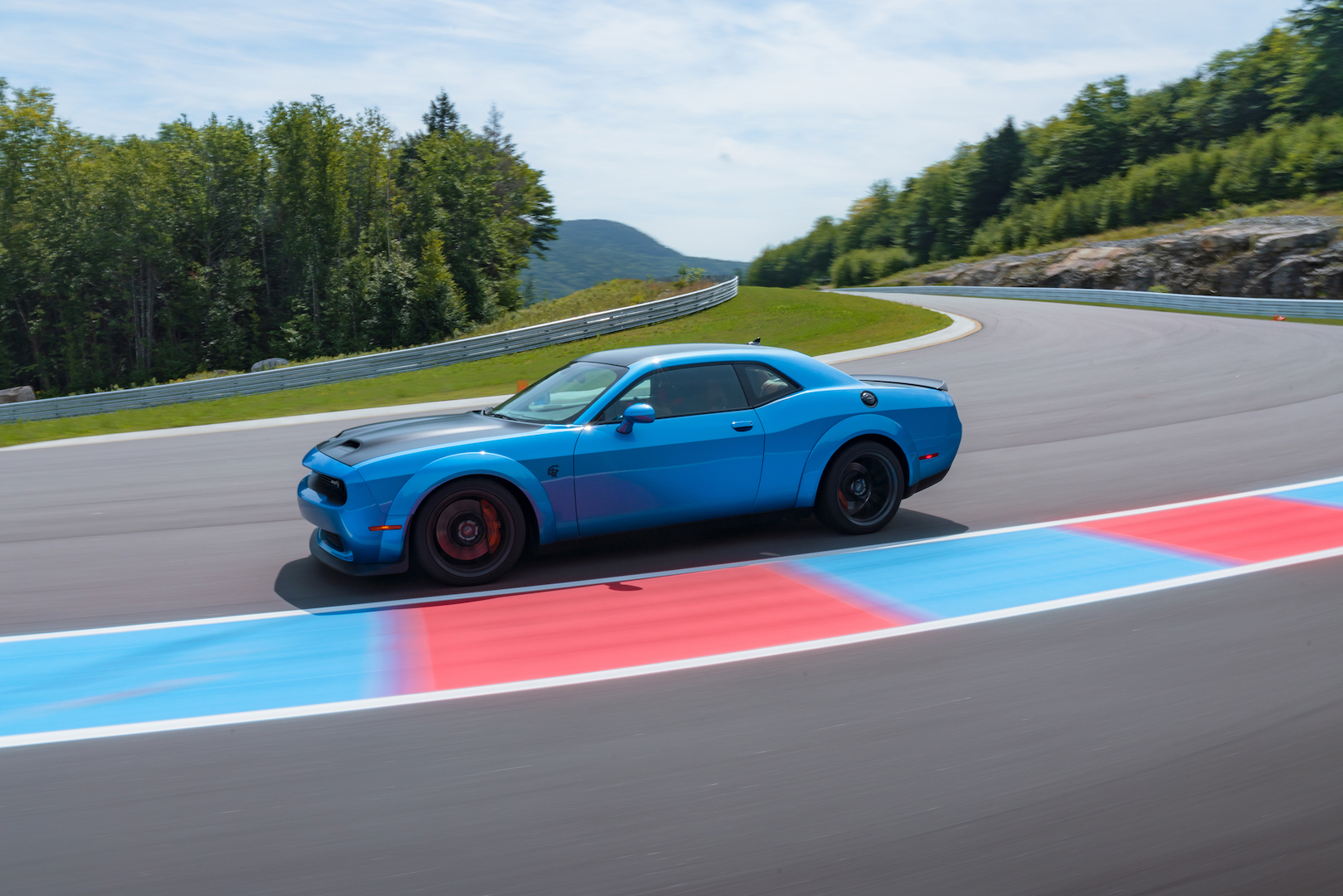
Back to money for a second. The SRT Hellcat Redeye’s $72,685 price undercuts the Demon's by roughly $13,000, and there’s no limit, aside from demand, on how many Dodge can build. But the Challenger R/T Scat Pack is undoubtedly the sweet spot of the lineup for its balance of performance and value. It starts from $40,130, and it’s a very appealing muscle car at that price. If you prefer your racing straight, the 1320 package adds $3,995. Rising through the ranks, the $6,000 Widebody treatment makes any Challenger look meaner and drive better. But if, like me, you still think of a Challenger as an Everyman (or Everywoman) muscle car, the Widebodys can also bust a budget. I'd recommend going easy on the options from that point, or widening those hips may also empty your wallet. To wit: Engorged with the Widebody package and multiple options, the R/T Scat Pack I drove reached $55,569. For me, that’s sneaking uncomfortably close to a standard 717-hp Hellcat, which starts from $60,350—and that’s with a $1,700 gas-guzzler tax. Yes, Dodge, Chevy, and Ford fans tend to stay in their little boxes, or just come out fighting. But cross-shoppers may notice that a 455-hp Camaro SS 1LE or Mustang GT Performance Pack can be had for well under $50,000. Either of those cars will whup an R/T Scat Pack—even the Widebody—on a racetrack or winding road. The Camaro, especially, can circle a road course as quickly as some big-name sports cars, or even some supercars.
Of course, most Dodge fans are fully aware of all that. Bless their burnt-rubber hearts, they just don’t care. That’s because there’s only one place they’ll want to race Fords and Chevys, and it won’t be a road course.
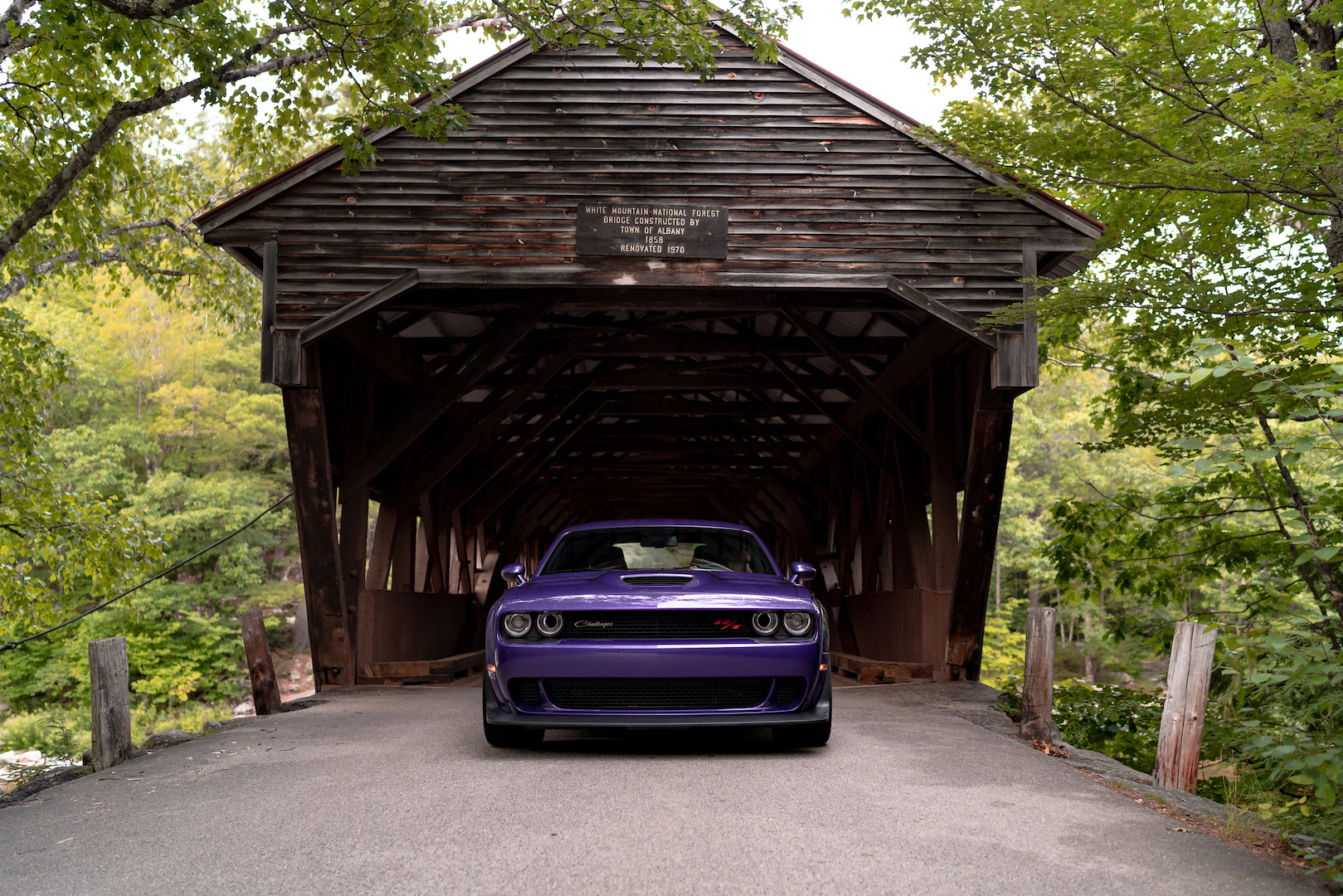
Sure enough, the Challengers rose to the occasion the second we departed the track. I'd already co-driven a Scat Pack Widebody to the track from Portland, Maine, enough time for a Maine trooper to nail my driving partner for doing 76 mph in a 55 zone—76 being a speed that feels more like 55 in a Challenger. The officer turned out to be a huge muscle car fan who let us off with barely a warning, and we assumed he hung a U-turn and pulled us over just to check out the car. (Score one for Dodge).
For the return leg, we requisitioned a Redeye. And we weren't two miles from the track before I was squealing the tires, fishtailing sideways, and causing New Hampshire citizens to give me serious stink eye. My driving partner did the same when we switched spots, leaving one patch of rubber after another through sleepy towns. With 797 horses underfoot, it takes a disciplined right foot to get the Redeye to hook up smoothly in first gear (or even second), but dissolving tires is what it’s all about.

Yet there was grip to spare on this Redeye flight, as I barreled through sweepers and stormed up behind innocents in their New England Subarus: windows down, Hemi V8 blasting, the supercharger whistling as demonically as Daryl Hannah’s assassin in Kill Bill: Volume 1. And the street is where you notice the Challenger’s other good stuff, including its surprisingly livable nature. Dodge itself defines the Challenger as a GT, and while it’s surely no Aston Martin, the Challenger’s agreeable ride, lavish features and infotainment, and relatively spacious interior and trunk make it an appealing daily driver—or even a family car, though the four-door Charger is even more versatile.
On urban or suburban streets—freeways, too—the Camaro’s and Mustang’s handling advantages are blunted, and the Challenger’s strengths are heightened. There, the Challenger makes me feel like a party-hearty, rule-breaking teenager whenever I take the wheel. I’m not sure if that’s a good thing, but I’ll take it.
Lawrence Ulrich,The Autance’s chief auto critic, is an award-winning auto journalist and former chief auto critic for The New York Times and Detroit Free Press. The Detroit native and Brooklyn gentrifier owns a troubled ’93 Mazda RX-7 R1, but may want to give it a good home. Email him at [email protected].
